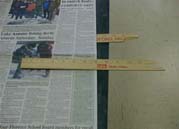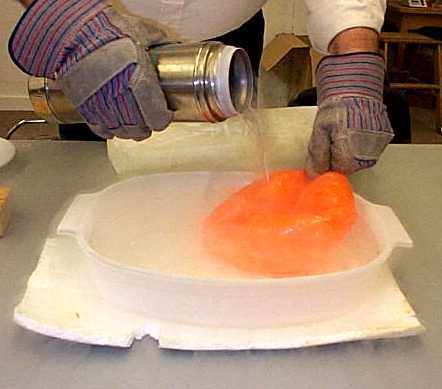
UBC Physics - Air Pressure Demonstration
Lesson Plan
This is a suggested lesson plan for the presentation. It was used in two presentations at Carson Graham Secondary for a resource science class and a grade 8 science class.
Materials Needed
- newspaper
- yard stick
- balloons or sealable metal/plastic container
- liquid nitrogen (and some means to transport/handle it) or a kettle
- saftey googles and gloves
- styrofoam container
- computer running kinetic gas simulator
- hovercraft
- shopvac leaf blower
1. Newspaper/Yard Stick Demonstration
Time to complete: < 5 minutes
Place a yard stick half way over the end of a table. Then smoothly placed a few (2-3) sheets of newspaper on the table, covering the yard stick, as seen below.

Ask the class what will happen if you strike the end of the yard stick. After the students have decided, strike the free end of the yard stick quickly. If done correctly, the yard stick will not significantly lift the newspaper as the force due to air pressure over the area of the newspaper is larger than that of the strike. If struck hard enough, the yard stick will break in half, as seen below.

Ask the students for an explanation. Later you can come back to this experiment and calculate the amount of force on the newspaper.
2. Pressure and Kinetic Theory Discussion
3. Balloon Inflation Demonstration
Time to complete: 5 minutes
Describe how a balloon is inflated with respect to air pressure. Emphasize that you are increaseing the number of particles within the balloon and the only way for the pressure to equalize is for the volume of the baloon to increase.
Use the Kinetic Gas Simulator to demonstrate this affect my dragging the particle slider to the right to increase the number of particles.
4. Balloon/Metal Can Temperature Demonstration
Time to complete: 10 minutes
This demonstration will depend on the available materials. If liquid nitrogen is available (and feasible), then a balloon will be used, and the liquid nitrogen will cool the air inside the balloon. If not, a metal container can be substituted and water inside the container can be heated and cooled to get a similar effect. Demonstrate the effects due to temperature on air pressure by cooling the air inside a balloon and then allowing it to deflate as it cools, as seen below.

5. Calculation of Force Due to Air Pressure
Time to complete: 10 minutes
Recap that pressure is related to force, and such can calculate the force on an object if we know the surface area of the object. Get students to measure the length and width of the newspaper and from that determine the force pushing down on the newspaper. The calculation can be done on slide 9.
6. Hovercraft Demonstration
Time to complete: 15 minutes
After a short discussion on how a hover craft works, demonstrate
the working hovercraft. Students may be skeptical that it will work